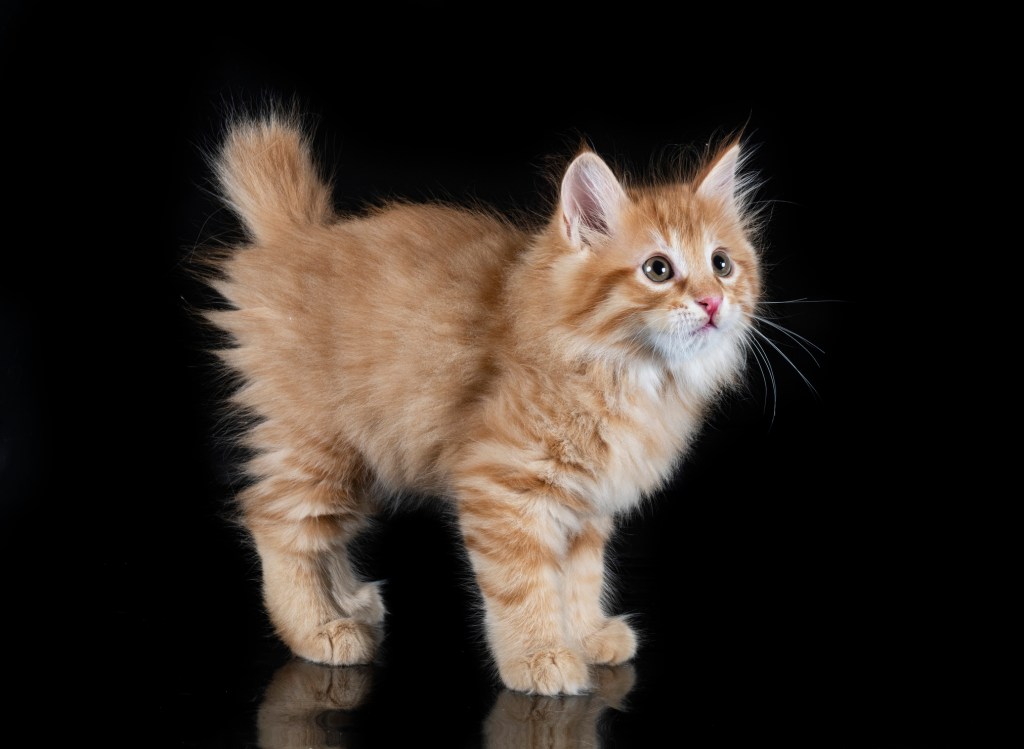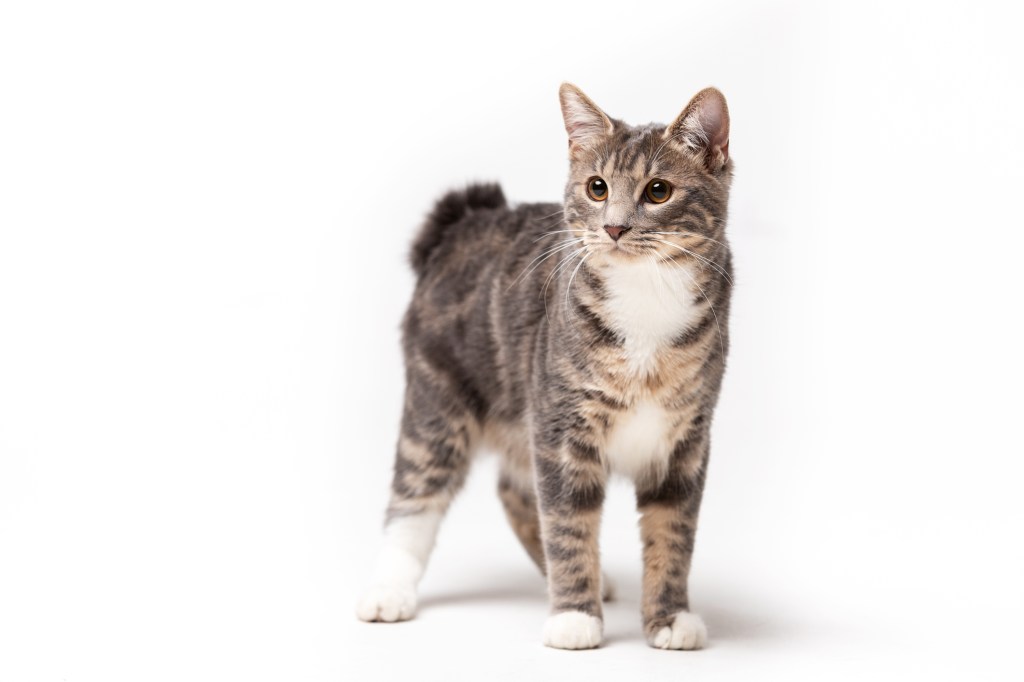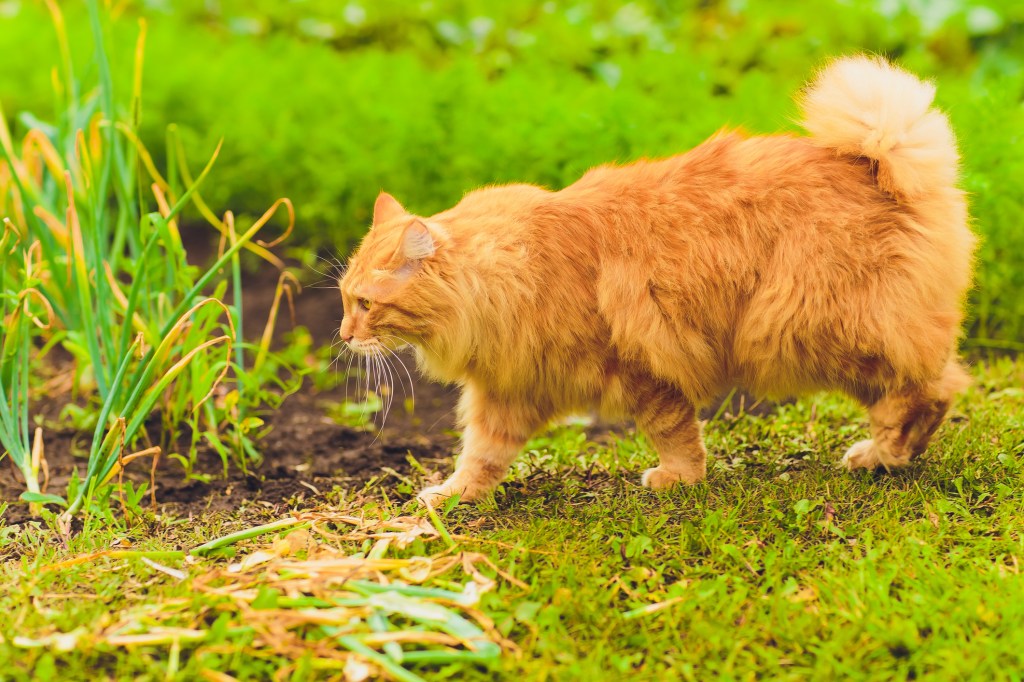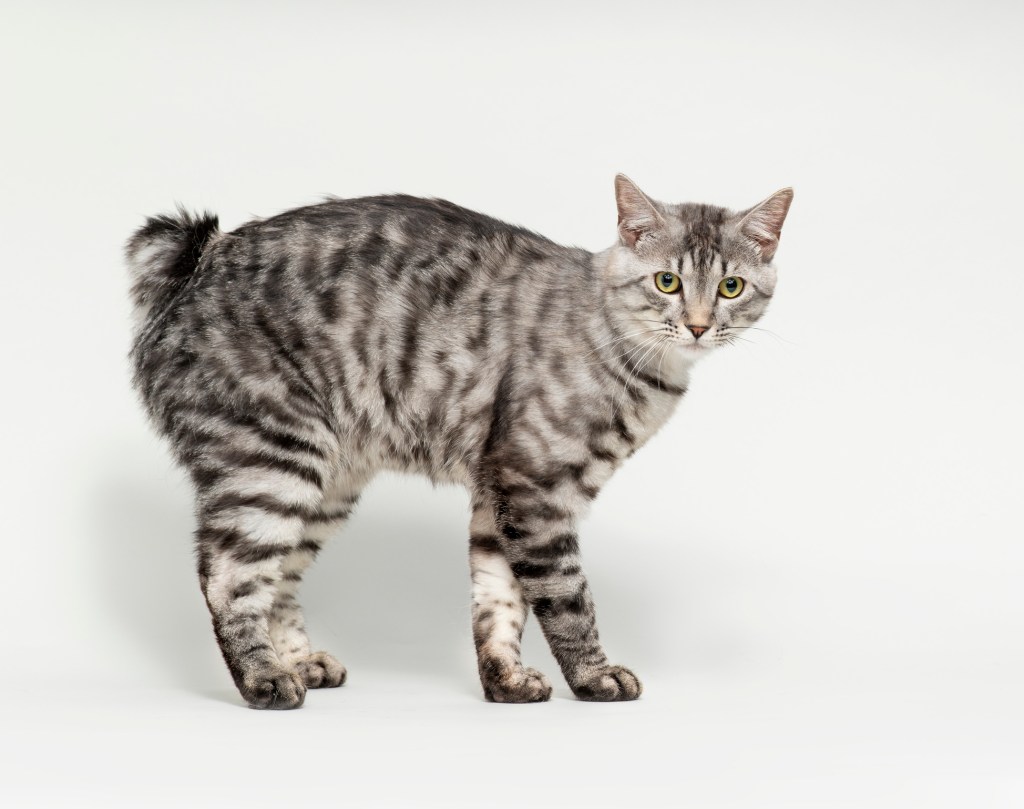The cat with the pom pom tail, the Kurilian Bobtail, is a bob-tailed cat breed hailing from a group of islands nestled between Russia and Japan. This rare, unique kitty is adventurous and adorable, with a long, rich history, as well. Naturally developing over time in the Kuril Islands, the Kurilian Bobtail is one of the few cat breeds that loves to play in water.
What are the characteristics of the Kurilian Bobtail?
Kurilian Bobtail cats have a strong body, tufted ears, and a bobbed tail that can come in three varieties: whisk, spiral, and snag. An orange Kurilian Bobtail, a grey Kurilian Bobtail, a black Kurilian Bobtail — they’re all possible because they come in a wide variety of colors and coat lengths. This uncommon breed has a wild look, most likely due to their development without any human intervention.
Despite their daring appearance, the Kurilian Bobtail is gentle and adoring, often having a strong bond with one person. This active and outgoing cat makes a wonderful family pet and gets along with everyone. That being said, they are excellent hunters on land and sea, so make sure to keep your hamsters in their cages.
When considering a Kurilian Bobtail kitten, it’s advisable to prioritize adopting from rescue organizations or shelters to provide a loving home to a cat in need. However, if you decide to purchase, it’s crucial to choose a reputable breeder. Conduct thorough research to ensure that the breeder follows ethical practices and prioritizes the well-being of their cats. Reputable Kurilian Bobtail cat breeders prioritize the health and temperament of their cats, conduct necessary health screenings, and provide a nurturing environment for the kitties. This active approach ensures that you bring home a healthy and happy kitty while discouraging unethical breeding practices.
Quick Facts
- Origin: Kamchatka Peninsula, Russia.
- Size: Medium (7-16 pounds), with males generally larger than females.
- Breed Group: Landrace (natural breed)
- Lifespan: 15-20 years, known for their longevity.
- Coat: Short or semi-longhaired, comes in a wide variety of colors and patterns, including solid, tabby, tortoiseshell, and bi-color.
- Temperament: Intelligent, playful, adaptable, affectionate, social, enjoys human interaction and playtime.
- Exercise Needs: Moderate – enjoys exploring, climbing, and games, but also content with cuddles.
- Training: Easily trainable due to their intelligence and desire to please, can learn tricks and even leash training.
- Grooming: Weekly brushing for short-haired, more frequent for semi-longhaired, to prevent matting.
- Health: Generally healthy, but some potential for genetic health conditions
- The Kuril Archipelago extends towards Japan, so the Kurilian Bobtail cat and the Japanese Bobtail may be distantly related.
- This breed is an excellent fisher, and loves to play in water.
- The Kurilian Bobtail cat’s tail is like a fingerprint: 100% unique. They come in three types: whisk, spiral, and snag.
Kurilian Bobtail Pictures




-
Affectionate with Family
Some cat breeds are typically independent and aloof, even if they’ve been raised by the same person since kittenhood; others bond closely to one person and are indifferent to everyone else; and some shower the whole family with affection. Breed isn’t the only factor that goes into affection levels; cats who were raised inside a home with people around feel more comfortable with humans and bond more easily.

See Cats Less Affectionate with Family -
Amount of Shedding
If you’re going to share your home with a cat, you’ll need to deal with some level of cat hair on your clothes and in your house. However, shedding does vary among the breeds. If you’re a neatnik, you’ll need to either pick a low-shedding breed or relax your standards. This furniture cover can make it easier to clean up cat hair and keep it off your sofa!
-
General Health
Due to poor breeding practices, some breeds are prone to certain genetic health problems. This doesn’t mean that every cat of that breed will develop those diseases; it just means that they’re at an increased risk. If you’re looking only for purebred cats or kittens, it’s a good idea to find out which genetic illnesses are common to the breed you’re interested in.
-
Potential for Playfulness
Some cats are perpetual kittens—full of energy and mischief—while others are more serious and sedate. Although a playful kitten sounds endearing, consider how many games of chase the mouse-toy you want to play each day, and whether you have kids or other animals who can stand in as playmates. A classic wand cat toy like this one is perfect for playful felines!
-
Tendency to Vocalize
Some breeds sound off more often than others with meows, yowls, and chattering. When choosing a breed, think about how the cat vocalizes and how often. If constant “conversation” drives you crazy, consider a kitty less likely to chat.
-
Kid-Friendly
Being tolerant of children, sturdy enough to handle the heavy-handed pets and hugs they can dish out, and having a nonchalant attitude toward running, screaming youngsters are all traits that make a kid-friendly cat. Our ratings are generalizations, and they’re not a guarantee of how any breed or individual cat will behave; cats from any breed can be good with children based on their past experiences and personality.
-
Friendly Toward Strangers
Stranger-friendly cats will greet guests with a curious glance or a playful approach; others are shy or indifferent, perhaps even hiding under furniture or skedaddling to another room. However, no matter what the breed, a cat who was exposed to lots of different types, ages, sizes, and shapes of people as a kitten will respond better to strangers as an adult.
-
Easy to Groom
Some breeds require very little in the way of grooming; others require regular brushing to stay clean and healthy. Consider whether you have the time and patience for a cat who needs daily brushing. You should definitely pick up this awesome de-shedding tool for cats of any hair length!
-
Intelligence
Some cat breeds are reputed to be smarter than others. But all cats, if deprived the mental stimulation they need, will make their own busy work. Interactive cat toys are a good way to give a cat a brain workout and keep them out of mischief. This scratcher cat toy can keep your smart kitty busy even when you’re not home!
-
Pet Friendly
Friendliness toward other household animals and friendliness toward humans are two completely different things. Some cats are more likely than others to be accepting of other pets in the home.
Kurilian Bobtail History
The Kurilian Bobtails can chart their history back to the Kuril Islands, which are situated between Japan and Russia. For over 200 years, these cats have endeared themselves to the local population due to their excellent vermin hunting abilities. However, due to their relatively small litter size, the breed has not spread around the world as quickly as other breeds.
The Kurilian Bobtail is officially acknowledged as a natural cat breed by the International Cat Association (TICA), and was granted full championship status in 2012. These days, you can find Kurilian Bobtails in shelters or in the care of rescue groups. So make sure to consider adoption if you decide that this is the breed for you!
Kurilian Bobtail Size
The Kurilian Bobtail is a medium- to large-sized cat. As is always the case, exact size standards might vary.
Most Kurilian Bobtails weigh in at eight to 15 pounds, with the females often being smaller than the males.
Kurilian Bobtail Personality
When it comes down to the Kurilian Bobtail’s personality, most owners of the breed remark just how sociable the cat is. This is a feline who’s friendly towards humans and other animals alike and will actively seek out people and other pets to interact with.
Befitting this social streak, the Kurilian Bobtail loves to play–so make sure you can provide enough time and attention to satisfy their exercise needs. The breed is smart and curious, so adding interactive toys to your home environment will be a must. Just remember that, due to their heritage as a cat with excellent hunting instincts, you’ll want to closely socialize any early interactions with smaller pets–and it might not be a great idea to have fish around the feline!
At the end of the day, the Kurilian Bobtail is also a very loving kitty who will definitely want to try and snuggle up to you when it’s bed time.
Kurilian Bobtail Health
Kurilian Bobtails are generally considered to be healthy cats. As always, it’s important to schedule regular wellness visits with your cat’s vet. There aren’t any breed-specific health problems associated with the Kurilian Bobtail, but always keep an eye out for signs that your cat might be in distress or pain.
Kurilian Bobtail Care
As with all cats, it’s important to keep up your Kurilian Bobtail’s regular veterinary checkups to detect any health concerns early. Your vet can help you develop a care routine that will keep your cat healthy.
Beyond scheduling yearly wellness visits with your vet, make sure that you pick up a scratching post for your Kurilian Bobtail’s living environment–this can help promote healthy scratching and keep the cat’s nails in good condition. This is especially important with a cat with high hunting and chasing instincts like the Kurilian Bobtail.
The breed’s ears should also be examined regularly for signs of dirt building up or possible infection. Talk to your vet about starting a regular teeth brushing regimen that will suit your Kurilian Bobtail. Your vet can advise you about specific brands and techniques.
Finally, for such an active cat, the Kurilian Bobtail definitely needs to be provided with enough space to be able to run around and satisfy their exercise needs–so consider adding a cat tree to your home an absolute must.
Kurilian Bobtail Coat Color And Grooming
The Kurilian Bobtail can be found in a very large range of colors, and they can also be solid or tabby. Some of the most eye-catching Kurilian Bobtails display silver streaks! When it comes to grooming, most Kurilian Bobtail’s are very low maintenance–the cat’s thick double coat will be good with weekly brushings. This will help lessen the likelihood of hairballs and mats forming.
In terms of climate, the Kurilian Bobtail is generally an adaptable breed of cat. Although you should always make sure that there’s enough shade and fresh water available during the hotter months.
Children And Other Pets
The Kurilian Bobtail is a great fit with young children, mainly because this is an outgoing and playful breed. Just be sure that early socialization takes place and boundaries are properly set on both sides–and supervise early interactions between kids and cats.
When it comes to other household pets, the Kurilian Bobtail fares well with many domestic animals, including dogs. But always supervise early interactions between the new cat and existing pets, especially smaller ones that might be seen as prey by the cat. Ultimately, early socialization really pays off with this breed. Make sure to reward your Kurilian Bobtail for good behavior when you bring them home to your family!
Kurilian Bobtail Rescue Groups
It may be hard to find a breed specific rescue for Kurilian Bobtail cats because they are an uncommon breed. However, you may want to try shelters and rescues that cater to all types of cats, including Kurilian Bobtails, as well as your local shelter. Here are some nonprofit rescues you can try:
More Info For You
If you’re also looking for a dog, check out DogTime’s dog breed page!
